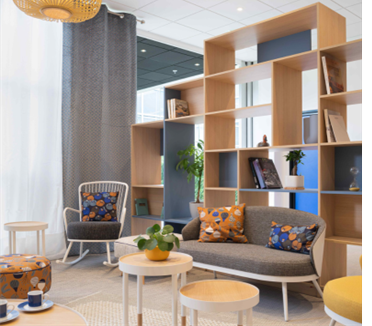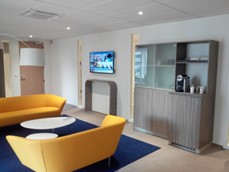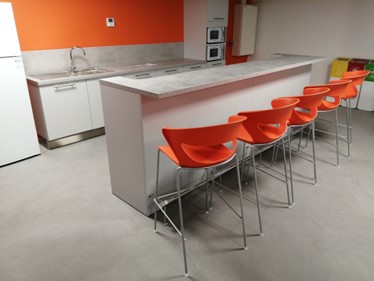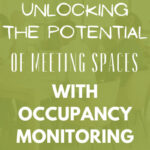
Just a few years ago, it would have been unthinkable to find ping-pong tables, beanbag chairs, or even TV rooms in professional settings. This rapid evolution is driven by an increasing demand from employees for a work experience that is greatly enhanced in terms of friendliness.
But do these amenities only benefit employees, or does the employer also reap rewards? And how can these spaces be designed to truly fulfill their purpose?
If you’re hesitant about incorporating a relaxation area into your business, our guide might just change your mind!
Relaxation space: Layouts examples
Each company should find the layout that best matches its culture and needs. Here are some examples of possible configurations:
- Game room
- Reading nook with library

An example of Motilde’s work
- Lounge-style relaxation area

An example of Motilde’s work
- Meditation and yoga room
- Cafeteria or fully equipped kitchenette

An example of Motilde’s work
- Indoor garden or green area
- Gym with fitness equipment
- Outdoor terrace
Essential elements for an optimal relaxation space
Generally, relaxation spaces should strike a balance between being personal and entirely open, to encourage spontaneous social interactions, which are often rich in creativity and positive team reinforcement.
Paradoxically, these areas are often very important for the company’s population who spend the least amount of time in the office, particularly remote workers.
While the ambiance of these spaces should remain friendly – with coffee machines, cozy decor, and casual seating being essential – the professional purpose must not be overlooked. Otherwise, why not just head down to the nearby bar, which is more than happy to welcome customers?
Considering this alternative (which can also be quite appealing 😊), a few points deserve your attention when creating these third spaces:
Identity
Your team members should feel at home, thereby strengthening their sense of belonging to the same team. Thus, the design and interior decoration of these “in-between” spaces should not be overlooked.
Ergonomics and comfort
The layout of a relaxation space should prioritize the physical comfort of employees. The use of ergonomic furniture, such as relaxing chairs and adjustable tables, is recommended. Ergonomics aim to reduce bodily tension and promote muscle relaxation.
Flexibility
The spontaneous nature of interactions in a relaxation area requires great flexibility: the number of people, the nature of discussions, etc., are not predetermined. This implies the need for adaptable furniture: movable acoustic partitions, furniture on casters, lightweight seating, etc.
Moreover, a high-performance Wi-Fi connection throughout the area is essential.
Integration and accessibility
A relaxation space must be easily accessible to all employees, without interfering with the main workspace. The integration of this area into the work environment should encourage its spontaneous use while respecting the need for quiet and relaxation.
Lighting and acoustics
Natural light and good sound insulation are essential for creating a soothing environment. The availability of natural light depends on the unique characteristics of the space. Regarding acoustics, various solutions can be implemented, regardless of the building’s constraints:
- Wall acoustic panels: These devices, made from specific materials such as rock wool or acoustic foam, play a key role in absorbing sound waves, thus contributing to a more serene environment.
- Acoustic ceilings: Incorporating ceilings designed to absorb noise limits the spread of unwanted sounds, fostering a calm atmosphere conducive to relaxation.
- Movable partitions: Flexible and functional, these structures allow for space to be adjusted according to needs while providing an effective sound barrier between different relaxation areas.
- Curtains: Whether thick or specially treated for sound absorption, these curtains offer an elegant and practical solution for controlling a space’s acoustics.
- Absorbent flooring: Using thick carpets or acoustic tiles helps to muffle footsteps.
- Sound-absorbing furniture: Choosing furniture with acoustic properties, such as armchairs and sofas with high side walls, can significantly reduce sound transmission, promoting intimate conversation spaces.
- Use of natural elements: Plants do not just purify the air; they can also act as natural sound diffusers, adding an aesthetic dimension while improving the space’s acoustics.
Meal break spaces: The legal framework
The establishment of a meal space in a business is subject to legal standards that vary depending on the country and size of the company. These standards primarily concern hygiene, safety, break times, as well as tax and social obligations.
For small businesses (fewer than 50 employees), the regulations are generally less stringent. They can set up a simple dining area, provided it is clean, safe, and allows employees to consume their meals under good conditions. Flexibility is key, as long as the fundamental needs for safety and hygiene are met.
Large businesses (50 employees and more), on the other hand, must adhere to more stringent requirements. They are often required to provide a dedicated space equipped for food storage and reheating, in addition to complying with strict hygiene and safety standards. These companies must also ensure that the space is accessible to all employees, including those with disabilities, and ensure that the arrangements comply with labor regulations regarding break times.
The provision of a dining space can be considered a benefit in kind, with implications for the company’s social contributions.
Measuring the impact of a relaxation space
Firstly, it’s crucial to analyze employee performance indicators before and after the introduction of the relaxation space. This may include measures such as productivity, job satisfaction, turnover rate, and absenteeism. An improvement in these areas can suggest a positive impact of the relaxation space.
Next, gathering employee feedback through surveys or interviews can be beneficial. Their insights can provide valuable information on how they perceive and use the relaxation space, as well as its effect on their well-being and morale.
Direct observation of the relaxation space’s usage can also offer insights. Tracking the number of employees who regularly use the space, the activities they engage in, and the duration of their breaks can provide an indication of its usage and appeal.
Lastly, analyzing occupational health and safety data can offer clues about the relaxation space’s impact on the mental and physical health of employees. A reduction in work-related accidents due to stress or fatigue can be a positive sign of the effectiveness of the relaxation space.
Looking to set up your relaxation or collaborative work space?
The simplest approach is to consult an expert who can offer advice tailored to your needs.
Passionate about crafting workspaces that ignite collaboration, innovation, and productivity?
Download our free Ebook :







